
 |
No family is exempted from life crises, and with all the challenges they bring, it is the women who disproportionately bear the impact of crisis. According to an AARP study, in the case of divorce, 74 percent of women lessened their expenses, while only 59 percent of men did. For those who had properties, 56 percent of women sold their homes while 44 percent of men did the same. There were also around 42 percent of women who took a job or a second job, while only 21 percent of men did the same. The women in O'Connor's Lottie's Lot are no different.
This story chronicles the life of Lottie Walker-Hastings, using an intriguing blend of historical research and imaginative recreation. (Though the author met Lottie only twice as a child, her novel is based upon a real genealogy and employs both actual and screen names.) The Hastings had lived in the ebb and flow of world events, providing drama, romance, and lessons in history and life. From the first to the last chapter, O'Connor utilizes the Hastings women's romantic relationships to model gender roles in late 19th century North America. With her choice to open the first chapter of the book with Lottie rehearsing her excuses for her Father, O'Connor is hinting that social construction of gender issues will be at the center of the novel's story plot.
From Abbie's joyless married life to Hazel's unusual relationship with C.C., O'Connor reveals how dominant cultural values about equalities and economic and social realities affect the choices of women. While women in the late 19th century are on their way to achieving certain breakthroughs in the education, legal, and political arena, opportunities are still limited. For instance, Hazel finds it difficult to raise three kids on her own, thus making her dependent on C.C.
The author combines the outsider-observer and the insider-participant approach to come up with an objectified Hastings enriched by expressions of each member's experience. Presented to readers is a competent empirical work with an experiential touch. The conflicts wrought from different religious beliefs and daily practices (and yet choosing to stick together despite disagreements) is one of the strengths of the author's choice of the approach. Readers are given an idea how a non-drinking, well-mannered woman married a drinking, loud husband and begot a son and six daughters who engage in various social taboos. Such conflicts accentuated the novel's theme and challenged readers with opposing viewpoints.
As with any family, the narrative provides a saga of romance, tensions, rivalries, antagonisms, and even abuse. Due to the social milieu, poverty and a lack of opportunities complicate their personal relationships and life choices. However, this is not always the case. When readers consider Buddy's character, they can see another powerful force that transcends any social milieu: personal responsibility. Lottie's only son Buddy, the apple of the family's eye, flees home and submerges into alcohol. While Buddy could afford a better life for himself, he retreats to a mediocre lone, reminding us that some struggling people's problem is both a choice and personal responsibility, not the lack of real opportunity.
This book is a valuable resource for a course on family, life, child development, marriage counseling, anthropology, sociology, psychology, or any course that addresses issues of family engagement.